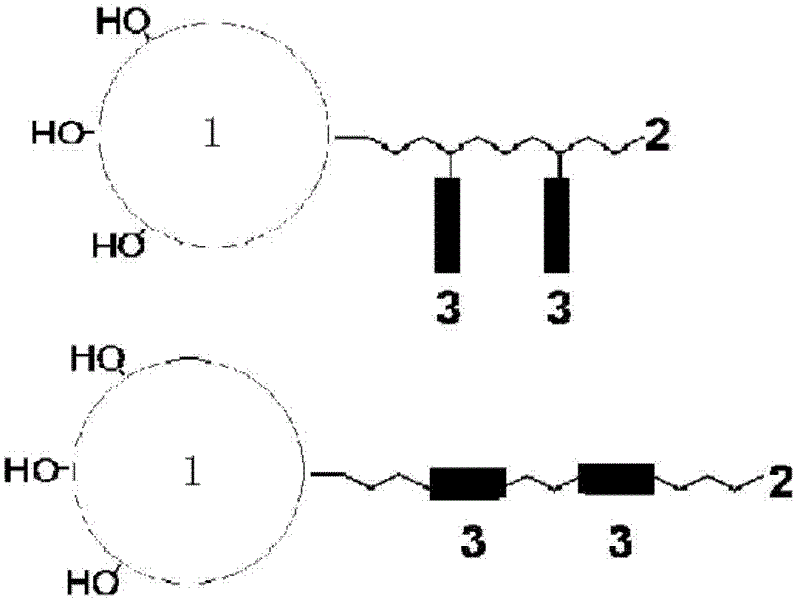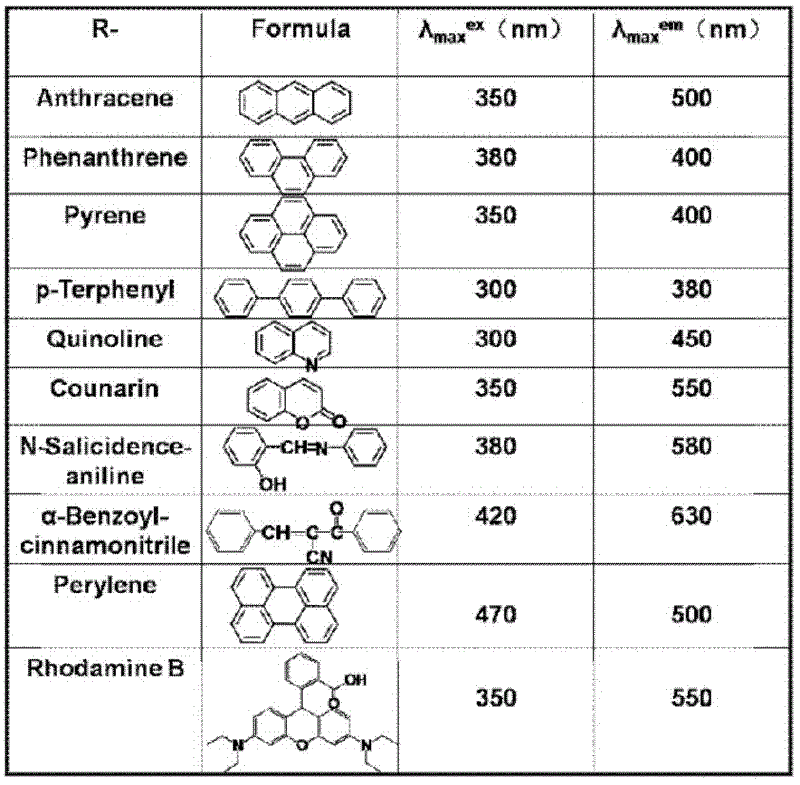Fluorescent nanoparticle as well as preparation method and application thereof
A nano-fluorescence and nano-particle technology, applied in the field of nano-fluorescence particles and their preparation, can solve problems such as difficult dispersibility, and achieve the effects of reducing power generation costs and improving photoelectric conversion efficiency.
- Summary
- Abstract
- Description
- Claims
- Application Information
AI Technical Summary
Problems solved by technology
Method used
Image
Examples
Embodiment 1
[0023] A preparation method of polyacrylic acid copolymer-silica nano fluorescent particles grafted with α-benzoyl cinnamonitrile (λmax (ex): 420nm; λmax (ex): 630nm) , with the following steps:
[0024] (1) Take 10 parts of nano-silica by mass ratio, add 10 parts of water, and stir at a high speed for 50 minutes through an emulsifier to obtain a light blue translucent nano-silica dispersion containing hydroxyl groups on the surface;
[0025] (2) Add 2 parts of KH-550 silane coupling agent to the system of step (1), continue to stir for 2 hours and then heat up to 85°C for reflux for 3 hours to obtain nano-silica containing amino groups on the surface, with an average particle size of 50nm. The mixture was centrifuged to take the precipitate, washed twice with absolute ethanol and toluene, and then dispersed in toluene; under the condition of ice-water bath, 2 parts of triethylamine and 4 parts of 2-bromoisobutyryl bromide were added to the system, and the reaction After 1 ho...
Embodiment 2
[0033] A polystyrene copolymer-silicon dioxide nano fluorescent particle grafted with anthracene (λmax (ex): 350nm; λmax (ex): 500nm), the preparation steps are as follows:
[0034] (1) Take 10 parts of nano-silica by mass ratio, add 10 parts of water, and stir at a high speed through an emulsifier to obtain a translucent light blue nano-silica dispersion with hydroxyl groups on the surface;
[0035] (2) Add the aqueous solution of 2 parts of silane coupling agent KH-858 in the system, after stirring 2h at room temperature, obtain the silicon dioxide that contains double bond on the surface, the average particle diameter is 50nm,
[0036] (3) Under a nitrogen atmosphere, raise the temperature of the system to 70°C, add dropwise 25 parts of potassium persulfate initiator, 250 parts of styrene and 50 parts of vinyl monomer containing Anthracene fluorescent group, and react at a constant temperature of 70°C for 12 hours , filtered and purified to obtain a product with an average ...
Embodiment 3
[0043] A preparation method of polyurethane-titanium dioxide nano fluorescent particles grafted with rhodamine B (Rhodamine B) fluorescent functional groups (λmax (ex): 350nm; λmax (em): 550nm), has the following steps:
[0044] (1) Take 10 parts of nano-titanium dioxide by mass ratio, add 10 parts of water, and stir at a high speed through an emulsifier to obtain a translucent light blue nano-silica dispersion with hydroxyl groups on the surface;
[0045] (2) Add 2 parts of KH-550 silane coupling agent to the system, continue to stir for 2 hours, then raise the temperature to 85° C. and reflux and stir for 3 hours to obtain nano-silica containing amino groups on the surface, with an average particle size of 50 nm, ready for use;
[0046] (3) First, 400 parts of diisocyanate (IPDI), 600 parts of macromolecular diol (PTMG), 2 parts of carboxyl small molecule diol (DMPA), 1 part of trimethylolpropane (TMP), Add 4 parts of Rhodamine B and 50 parts of acetone into the reaction ves...
PUM
| Property | Measurement | Unit |
|---|---|---|
| The average particle size | aaaaa | aaaaa |
Abstract
Description
Claims
Application Information
 Login to View More
Login to View More - R&D
- Intellectual Property
- Life Sciences
- Materials
- Tech Scout
- Unparalleled Data Quality
- Higher Quality Content
- 60% Fewer Hallucinations
Browse by: Latest US Patents, China's latest patents, Technical Efficacy Thesaurus, Application Domain, Technology Topic, Popular Technical Reports.
© 2025 PatSnap. All rights reserved.Legal|Privacy policy|Modern Slavery Act Transparency Statement|Sitemap|About US| Contact US: help@patsnap.com



